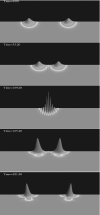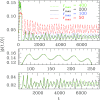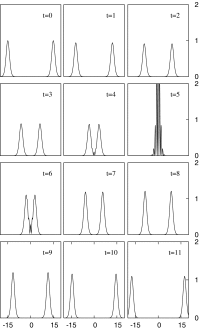Dynamical boson stars
- PMID: 29200936
- PMCID: PMC5684349
- DOI: 10.1007/s41114-017-0007-y
Dynamical boson stars
Abstract
The idea of stable, localized bundles of energy has strong appeal as a model for particles. In the 1950s, John Wheeler envisioned such bundles as smooth configurations of electromagnetic energy that he called geons, but none were found. Instead, particle-like solutions were found in the late 1960s with the addition of a scalar field, and these were given the name boson stars. Since then, boson stars find use in a wide variety of models as sources of dark matter, as black hole mimickers, in simple models of binary systems, and as a tool in finding black holes in higher dimensions with only a single Killing vector. We discuss important varieties of boson stars, their dynamic properties, and some of their uses, concentrating on recent efforts.
Keywords: Boson stars; Numerical relativity; Solitons.
Figures

























Similar articles
-
Dynamical Boson Stars.Living Rev Relativ. 2012;15(1):6. doi: 10.12942/lrr-2012-6. Epub 2012 May 8. Living Rev Relativ. 2012. PMID: 28163621 Free PMC article. Review.
-
GW190521 as a Merger of Proca Stars: A Potential New Vector Boson of 8.7×10^{-13} eV.Phys Rev Lett. 2021 Feb 26;126(8):081101. doi: 10.1103/PhysRevLett.126.081101. Phys Rev Lett. 2021. PMID: 33709746
-
Two Spinning Black Holes Balanced by Their Synchronized Scalar Hair.Phys Rev Lett. 2023 Sep 22;131(12):121401. doi: 10.1103/PhysRevLett.131.121401. Phys Rev Lett. 2023. PMID: 37802955
-
Great Impostors: Extremely Compact, Merging Binary Neutron Stars in the Mass Gap Posing as Binary Black Holes.Phys Rev Lett. 2020 Feb 21;124(7):071101. doi: 10.1103/PhysRevLett.124.071101. Phys Rev Lett. 2020. PMID: 32142310
-
Formation of black hole and emission of gravitational waves.Proc Jpn Acad Ser B Phys Biol Sci. 2006 Dec;82(9):311-27. doi: 10.2183/pjab.82.311. Epub 2006 Feb 12. Proc Jpn Acad Ser B Phys Biol Sci. 2006. PMID: 25792793 Free PMC article. Review.
Cited by
-
An exceptional G(2) extension of the Standard Model from the correspondence with Cayley-Dickson algebras automorphism groups.Sci Rep. 2021 Nov 18;11(1):22528. doi: 10.1038/s41598-021-01814-1. Sci Rep. 2021. PMID: 34795323 Free PMC article.
References
-
- Aad G, et al. Observation of a new particle in the search for the standard model Higgs boson with the ATLAS detector at the LHC. Phys Lett B. 2012;716:1–29. doi: 10.1016/j.physletb.2012.08.020. - DOI
-
- Abbott BP, et al. Exploring the sensitivity of next generation gravitational wave detectors. Class Quantum Gravity. 2017;34:044001. doi: 10.1088/1361-6382/aa51f4. - DOI
Publication types
LinkOut - more resources
Full Text Sources
Other Literature Sources
